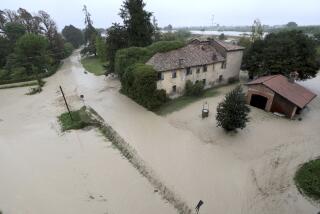Op-Ed: El Niño: Preparing now for disasters later
For much of this year, some of the world’s most vulnerable people have found themselves in the grip of El Niño, a profound and confounding natural disaster that brings with it severe floods, severe drought and, potentially, more intense and more frequent cyclones.
Arriving every three to seven years to warm parts of the Pacific – in turn affecting weather systems around the globe – El Niño is anything but benign, as it builds on an already changing climate and strains the ability of millions of people to cope. This time, it has been cited as one of the strongest El Niños the world has seen in nearly a century.
The result – severe floods in some parts of the world and drastic droughts in others – has hit many millions hard. In the Horn of Africa, about 20 million people are at risk of starvation or hunger as drought takes hold. Floods in parts of southern Africa and Latin America have also been devastating.
Some countries, like Angola, have actually seen droughts and floods at the same time within their borders.
While El Niño has started to decline in strength, the danger is not over. El Niño will continue to have a strong impact, and, even when that has passed, the world may witness La Niña – another potentially devastating weather event that frequently follows El Niño. Together, they may continue to exert their grip for as long as two years.
The humanitarian response to El Niño is a critical priority right now, as it should be. But when this El Niño begins to fade, as surely it will, we must not forget about it until the next time it occurs. Disasters will happen. And El Niño will happen again. Now is the time to plan for these events and now is the time to prepare.
Not for a moment am I suggesting that the pressing needs we are seeing around the world right now be ignored or forgotten. But we must also seize this opportunity to build the resilience of affected countries and communities so that we are not reliving this crisis again and again.
Simply put, we must support governments as they take the lead on building long-term resilience, because that support is a down payment against humanitarian crises – and not just those caused by El Niño and La Niña, but any disaster caused by extreme weather. That is especially important as climate change brings ever more extreme weather.
Here’s just one example: By considering both the potential of natural disasters and the impact of climate change, the United Nations Development Program and the government of Sweden supported Uganda as it took measures to cope with the predicted impacts of El Niño. Some of those measures allowed local officials to help people build dams during rainfalls and manage pastures to ensure their livestock would survive a drought.
Many of the countries that are suffering today or will suffer tomorrow are trapped in a cruel cycle: A humanitarian response leads to an eventual recovery and finally meaningful development – only to be devastated by another natural disaster and having to start all over again. In such a cycle, efforts to eradicate poverty and progress to achieve sustainable development goals are routinely and frustratingly set back. Building resilience will help end this cycle and protect people and resources.
While El Niño all too often results in more devastating disasters than almost anything nature can throw at the world, it has one key difference: its predictability. We have known about the phenomenon for a long time. We may not always know its strength, but we know it must be coming. And that’s crucial.
It is crucial because it means we can plan for El Niño. We can prepare for El Niño. We can help the many vulnerable countries, communities and people ready themselves for what we know will eventually come.
Jo Scheuer is director of climate change and disaster risk reduction at the United Nations Development Program’s Bureau for Policy and Program Support. U.N. agencies, international development banks and nongovernmental organizations from around the world were scheduled to meet Thursday in Rome to discuss El Niño, its effects and priorities for action.
ALSO
Scientology leader’s father to publish ‘Ruthless’ memoir
Documents portray Bowe Bergdahl, accused of desertion, as idealistic loner
Pentagon skips tests on key component of U.S.-based missile defense system
More to Read
Sign up for Essential California
The most important California stories and recommendations in your inbox every morning.
You may occasionally receive promotional content from the Los Angeles Times.










